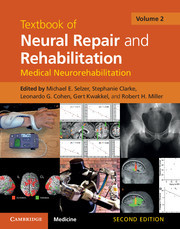Textbook of Neural Repair and Rehabilitation (2nd Ed., Revised edition) Textbook of Neural Repair and Rehabilitation 2 Volume Hardback Set Series
Langue : Anglais
Coordonnateurs : Selzer Michael E., Clarke Stephanie, Cohen Leonardo G., Kwakkel Gert, Miller Robert H.

Volume 2 of the Textbook of Neural Repair and Rehabilitation stands alone as a clinical handbook for neurorehabilitation.
In two freestanding volumes, Textbook of Neural Repair and Rehabilitation provides comprehensive coverage of the science and practice of neurological rehabilitation. Revised throughout, bringing the book fully up to date, this volume, Medical Neurorehabilitation, can stand alone as a clinical handbook for neurorehabilitation. It covers the practical applications of the basic science principles presented in Volume 1, provides authoritative guidelines on the management of disabling symptoms, and describes comprehensive rehabilitation approaches for the major categories of disabling neurological disorders. New chapters have been added covering genetics in neurorehabilitation, the rehabilitation team and the economics of neurological rehabilitation, and brain stimulation, along with numerous others. Emphasizing the integration of basic and clinical knowledge, this book and its companion are edited and written by leading international authorities. Together they are an essential resource for neuroscientists and provide a foundation of the work of clinical neurorehabilitation professionals.
Part I. Terminology of Neurorehabilitation – Outcome Measurement and Diagnostic Technology: 1. Clinical trials in neurorehabilitation; 2. Understanding the mechanisms underlying recovery after stroke; 3. Genetics in neurorehabilitation; 4. Outcomes measurement: basic principles and applications in stroke rehabilitation; 5. Human voluntary motor control and dysfunction; 6. Assessments, interventions, and outcome measures for walking; 7. Clinical pathways; 8. Electromyography in neurorehabilitation; 9. Functional neuroimaging; Part II. Therapeutic Technology: 10. Evolving insights into motor learning and their implications for neurorehabilitation; 11. Balance training; 12. Functional electrical stimulation in neurorehabilitation; 13. Peripheral nerve stimulation; 14. Brain stimulation; 15. Assistive devices; 16. Wheelchair design and seating technology; 17. Rehabilitation robotics, orthotics, and prosthetics for the upper extremity; 18. Rehabilitation robotics, orthotics, and prosthetics: lower limb; 19. Virtual reality applications in neurorehabilitation; 20. Communication devices; 21. Requirements for valid clinical trials; 22. Spinal cord injury: mechanisms, cellular and molecular therapies, and human translation; 23. Motor neuroprosthetics; Part III. Organization of Rehabilitation Services: 24. Neurohabilitative interventions in the acute stage of diseases; 25. The rehabilitation team and the economics of neurological rehabilitation; Part IV. Symptom-Specific Neurorehabilitation – Sensory and Motor Dysfunctions: 26. Chronic pain; 27. Loss of somatic sensation; 28. Management of deforming spastic paresis; 29. Contemporary concepts in upper extremity rehabilitation; 30. Gait disorders and rehabilitation; 31. Balance function and dysfunction and the vestibular system; 32. Deconditioning and energy expenditure; Part V. Vegetative and Autonomic Dysfunctions: 33. Acute neurorehabilitation for disorders of consciousness; 34. Plasticity in the neural pathways for swallowing: role in rehabilitation of dysphagia; 35. Autonomic dysfunction; Part VI. Cognitive Rehabilitation: 36. Rehabilitation for aphasia; 37. Apraxia; 38. Unilateral neglect and anosognosia; 39. Memory dysfunction; 40. Neurorehabilitation of executive functions; 41. Rehabilitation of visual field impairment; Part VII. Disease-Specific Neurorehabilitation Systems: 42. Rehabilitation of dementia; 43. Traumatic brain injury; 44. Neurorehabilitation in epilepsy; 45. Parkinson's disease and other movement disorders; 46. Predicting activities after stroke; 47. Evidence-based benefit of rehabilitation after stroke; 48. Rehabilitation in spinal cord injury; 49. Multiple sclerosis; 50. Neuromuscular rehabilitation: diseases of the motor neuron, peripheral nerve, neuromuscular junction and the muscle; Index.
Michael Selzer is Director and Professor, Department of Neurology at Shriners Hospitals Pediatric Research Center, Temple University School of Medicine, Philadelphia, PA, USA.
Stephanie Clarke is Professor, Service de Neuropsychologie et de Neuroréhabilitation, Centre Hospitalier Universitaire Vaudois, Université de Lausanne, Switzerland.
Leonardo Cohen is Professor, Human Cortical Physiology Section and Stroke Neurorehabilitation Section, National Institutes of Neurological Disorders and Stroke, National Institutes of Health, Bethesda, MD, USA.
Gert Kwakkel is Professor of Rehabilitation Medicine, Move Research Institute, VU University Medical Center (VUmc), Amsterdam; Centre of Excellence for Rehabilitation Medicine, Rehabilitation Centre 'De Hoogstraat' and Department of Rehabilitation and Sports Medicine, Rudolf Magnus Institute of Neuroscience, UMC Utrecht, Utrecht, The Netherlands.
Robert Miller is Vice Dean for Research, Department of Neuroscience, Center for Translational Neuroscience, Case Western Reserve University, Cleveland, OH, USA.
Stephanie Clarke is Professor, Service de Neuropsychologie et de Neuroréhabilitation, Centre Hospitalier Universitaire Vaudois, Université de Lausanne, Switzerland.
Leonardo Cohen is Professor, Human Cortical Physiology Section and Stroke Neurorehabilitation Section, National Institutes of Neurological Disorders and Stroke, National Institutes of Health, Bethesda, MD, USA.
Gert Kwakkel is Professor of Rehabilitation Medicine, Move Research Institute, VU University Medical Center (VUmc), Amsterdam; Centre of Excellence for Rehabilitation Medicine, Rehabilitation Centre 'De Hoogstraat' and Department of Rehabilitation and Sports Medicine, Rudolf Magnus Institute of Neuroscience, UMC Utrecht, Utrecht, The Netherlands.
Robert Miller is Vice Dean for Research, Department of Neuroscience, Center for Translational Neuroscience, Case Western Reserve University, Cleveland, OH, USA.
Date de parution : 04-2014
Ouvrage de 760 p.
22.5x28.3 cm
Thème de Textbook of Neural Repair and Rehabilitation :
© 2024 LAVOISIER S.A.S.



